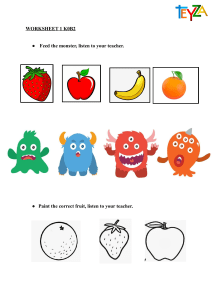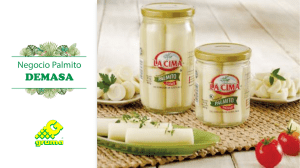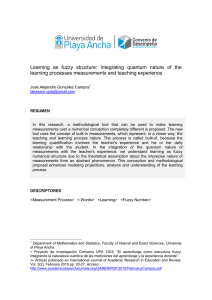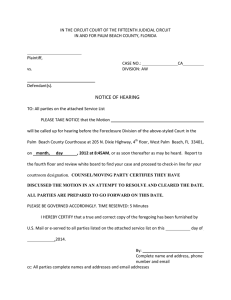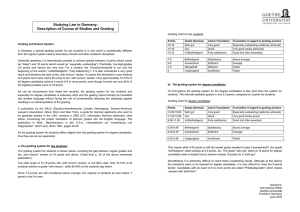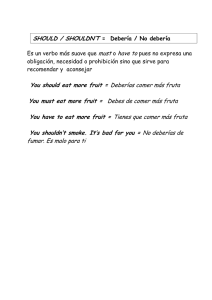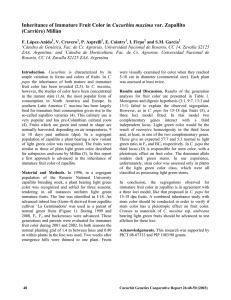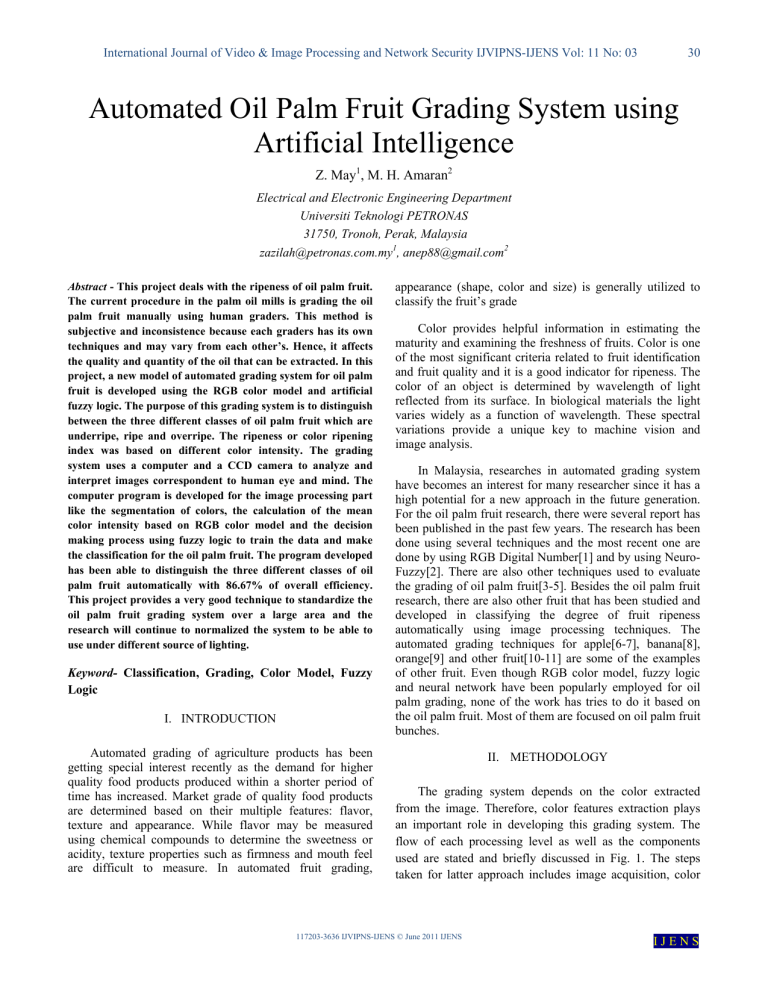
International Journal of Video & Image Processing and Network Security IJVIPNS-IJENS Vol: 11 No: 03 30 Automated Oil Palm Fruit Grading System using Artificial Intelligence Z. May1, M. H. Amaran2 Electrical and Electronic Engineering Department Universiti Teknologi PETRONAS 31750, Tronoh, Perak, Malaysia [email protected], [email protected] Abstract - This project deals with the ripeness of oil palm fruit. The current procedure in the palm oil mills is grading the oil palm fruit manually using human graders. This method is subjective and inconsistence because each graders has its own techniques and may vary from each other’s. Hence, it affects the quality and quantity of the oil that can be extracted. In this project, a new model of automated grading system for oil palm fruit is developed using the RGB color model and artificial fuzzy logic. The purpose of this grading system is to distinguish between the three different classes of oil palm fruit which are underripe, ripe and overripe. The ripeness or color ripening index was based on different color intensity. The grading system uses a computer and a CCD camera to analyze and interpret images correspondent to human eye and mind. The computer program is developed for the image processing part like the segmentation of colors, the calculation of the mean color intensity based on RGB color model and the decision making process using fuzzy logic to train the data and make the classification for the oil palm fruit. The program developed has been able to distinguish the three different classes of oil palm fruit automatically with 86.67% of overall efficiency. This project provides a very good technique to standardize the oil palm fruit grading system over a large area and the research will continue to normalized the system to be able to use under different source of lighting. Keyword- Classification, Grading, Color Model, Fuzzy Logic I. INTRODUCTION Automated grading of agriculture products has been getting special interest recently as the demand for higher quality food products produced within a shorter period of time has increased. Market grade of quality food products are determined based on their multiple features: flavor, texture and appearance. While flavor may be measured using chemical compounds to determine the sweetness or acidity, texture properties such as firmness and mouth feel are difficult to measure. In automated fruit grading, appearance (shape, color and size) is generally utilized to classify the fruit’s grade Color provides helpful information in estimating the maturity and examining the freshness of fruits. Color is one of the most significant criteria related to fruit identification and fruit quality and it is a good indicator for ripeness. The color of an object is determined by wavelength of light reflected from its surface. In biological materials the light varies widely as a function of wavelength. These spectral variations provide a unique key to machine vision and image analysis. In Malaysia, researches in automated grading system have becomes an interest for many researcher since it has a high potential for a new approach in the future generation. For the oil palm fruit research, there were several report has been published in the past few years. The research has been done using several techniques and the most recent one are done by using RGB Digital Number[1] and by using NeuroFuzzy[2]. There are also other techniques used to evaluate the grading of oil palm fruit[3-5]. Besides the oil palm fruit research, there are also other fruit that has been studied and developed in classifying the degree of fruit ripeness automatically using image processing techniques. The automated grading techniques for apple[6-7], banana[8], orange[9] and other fruit[10-11] are some of the examples of other fruit. Even though RGB color model, fuzzy logic and neural network have been popularly employed for oil palm grading, none of the work has tries to do it based on the oil palm fruit. Most of them are focused on oil palm fruit bunches. II. METHODOLOGY The grading system depends on the color extracted from the image. Therefore, color features extraction plays an important role in developing this grading system. The flow of each processing level as well as the components used are stated and briefly discussed in Fig. 1. The steps taken for latter approach includes image acquisition, color 117203-3636 IJVIPNS-IJENS © June 2011 IJENS IJENS International Journal of Video & Image Processing and Network Security IJVIPNS-IJENS Vol: 11 No: 03 feature extraction and finally classification using fuzzy logic algorithm. Image An image is captured using Olympus E520. Grading (Fuzzy Logic) The classification is determined based on extracted color feature. Background Removal The unnecessary background is removed and converted to black. Color Feature Extraction The features are mean value of red, green and blue layers. Fig. 1: The flowchart of grading process A. Image Acquisition The oil palm fruits are collected from a plantation. The oil palm fruits are graded manually by human grader as soon as he collects the fruits. A total of 75 images are taken in the laboratory under controlled lighting using an Olympus E-520 digital camera. They are converted into JPEG format and resized to 640x480 pixel dimensions. Even though the best lighting is using direct sunlight but we are using the controlled lighting condition because this system is planned to use in the building. B. Background Removal The region of interest is the fruit itself without the background. The background is the noise to the image and it has to be removed. The background subtraction method is used to remove the white background. Fig. 2 shows the result of performing the background removal. underripe, ripe and overripe categories, we need to obtain a range of mean value of red, green and blue layer for each fruit. These ranges values are used as a reference and a range input of fuzzy logic system. A total of 75 images (i.e 25 underripe, 25 ripe and 25 overripe) are used in determining the range value of red, green and blue of each category. The mean values of red, green and blue layers are calculated using the following equations: MeanR = R / No. of pixels MeanG = G / No. of pixels MeanB = B / No of pixels MeanR MeanG MeanB R G B = = = = = = Mean value of Red layer Mean value of Green layer Mean value of Blue layer Red pixel Green pixel Blue pixel D. Grading Fuzzy Logic is a chosen method for classifying the oil palm fruit into underripe, ripe and overripe categories. This technique is selected because it represents a good approach when we want to interpret the decision making process of human to the computer. Currently, the oil palm fruit grading is done based on the experience of the human grader. This method needs to be replaced with a new approach that is able to standardize the grading process. Fig. 3 shows the complete process of developing a fuzzy inference system (FIS) for the grading process using MATLAB[12]. Surface Viewer Fig. 2: Background removal of oil palm fruit The color features of the oil palm fruit are analyzed based on the RGB color model. To classify the fruit into (1) (2) (3) Where: FIS Editor C. Color Feature Extraction 31 Membership Function Editor Rule Viewer Rule Editor Fig. 3: Fuzzy Inference System The process consists of 3 main steps: defining the input and output in Membership Function Editor, set the fuzzy rules in Rule Editor and obtaining the output for each rule in Rule and Surface Viewer. 117203-3636 IJVIPNS-IJENS © June 2011 IJENS IJENS Internatiional Journal of o Video & Imaage Processingg and Network Security IJVIP PNS-IJENS Vool: 11 No: 03 32 The gradinng system has three inputs (Red, ( Green and a Blue) and one output B o (Catego ory). The membbership functioons a builds usinng trapezoidal shapes since it gives the best are r result compareed to other shapes. A total of 17 ruules s statements are created in order to classify the t oil palm frruit c categories. Fig 7: The Memberrship Function reprresentation of bluee input. F 4: The Fuzzy Inference Fig I System consists c of three innputs and one outpput. Fig 8: The Membershipp Function represeentation of Categoory output. Fig 5: The Membership Funcction representationn of red input. Thhe fuzzy sets produce p 17 rulees statements in i order to classifyy the oil palm fruit’s categorry. Examples of o the rules are illustrated as folloows: T TABLE 1. FUZZY Y SETS RULES FO OR CLASSIFICA ATION M Functiion representation of green input. Fig 6: The Membership Rule 2 If Redd is low And Green G is low And Blue B is medium m Then category is Unnderripe Rule 12 If Redd is medium And Green G is high And Blue B is medium m Then category is Rippe 117203-3636 IJVIP PNS-IJENS © June 2011 IJENS Rule 5 R is low If Red Andd Green is highh Andd Blue is hedium Then category is Ripe R Rule 16 R is high If Red Andd Green is highh Andd Blue is mediuum Then category is Overripe O IJENS International Journal of Video & Image Processing and Network Security IJVIPNS-IJENS Vol: 11 No: 03 Fig. 4-8 below shows the rule viewers which consist of the system’s input and output and the defuzzification result column. The first to third column is the inputs which are red, green and blue values while the last column is the category column. The last row of the category column shows the defuzzification result where category of oil palm fruit is obtained. 33 III. RESULTS AND DISCUSSIONS The grading system developed is managed to classify the oil palm fruit into underripe, ripe and overripe categories. The mean value of red, green and blue layers of 5 training data from each category is calculated and tabulated in the graph below. 200 150 100 50 0 1 2 3 4 5 6 7 8 9 10 11 12 13 14 15 Underripe Ripe Red Overripe Green Blue Fig. 10: RGB values for underripe, ripe and overripe of training image. Fig. 9: Defuzzification result from the Rule Viewer Based on the Defuzzification result from the Rule Viewer from Fig. 9, the oil palm fruit fulfilled Rule 12 where red is medium, green is high and blue is medium. The value of the category is calculated by using the centroid method. Then the classification of oil palm fruit is determined based on the crisp logic given in Table 2. The RGB values are compared with each category in order to determine the suitable range of RGB value for each category. From Fig. 10, it is clearly seen that the three difference categories have a different color distributions. The overripe category has the highest red pixel, the ripe category has an average red pixel while the underripe category has the lower red pixel compared to overripe and ripe categories. The condition also similar for green and blue pixels but the difference between the three categories is not as much as the red pixel. The range values for the three different categories are used in the fuzzy logic system as the reference. The range is shown in the Table 3. TABLE2. FUZZICICATION ALGORITHMS TABLE 3. THE RANGE VALUE OF RGB OF THE TRAINING DATA Defuzzification Output (cat <= 65) (cat >= 66) && (cat <= 155) (cat >= 156) Oil Palm Fruit Category Underripe Ripe Overripe The value of cat is 100. Therefore, the oil palm used in this experiment is classified as ripe category. Red Green Blue Category Min Max Min Max Min Max Ripe 82.42 127.05 39.26 59.01 27.34 48.32 Underripe 52.53 81.95 19.85 33.22 15.26 26.88 Overripe 148.34 179.20 48.73 74.54 28.33 50.29 117203-3636 IJVIPNS-IJENS © June 2011 IJENS IJENS International Journal of Video & Image Processing and Network Security IJVIPNS-IJENS Vol: 11 No: 03 An example of misclassification of oil palm fruit is shown in Fig. 11. Based on human graders, the fruit is classified as underripe but the program classified it as ripe category. This problem occurs because of the color of the fruit lies in between underripe and ripe categories. 34 between two different categories and an additional feature that incorporate differences between the categories such as texture need to be added. The results of the fuzzy logic system are evaluated against the human graders to measure accuracy. It shows that the automated oil palm fruit grading system using fuzzy logic achieved 86.67% accuracy in overall categories. This shows that the grading system using fuzzy logic have a high potential of accuracy in grading the oil palm fruit. IV. CONCLUSION Fig. 11: The misclassification of oil palm fruit The details result of oil palm fruit classification is shown in Fig. 12. For red and green pixels, the values are lies in between two sections where this situation can misclassify the fruit. The study has proven that by using fuzzy logic algorithm, the accuracy of oil palm fruit grading is quite high. A graphical user interface was developed for the user to use the program easily. This technique begins with loading the image to the program. The image is then processed by image processing, calculated the mean RGB value and graded using fuzzy logic. The oil palm is classified based on RGB color. The results are shown on the surface viewer from the Fuzzy Toolbox. The oil palm fruit grading system can be improved by adding more training image from various places and choose the best range of RGB. ACKNOWLEGDEMENT We would like to thank Mr Shafie Shaari and Mr Faiz Shafie for providing the oil palm fruit sample and for their full cooperation and support throughout our research project. The oil palm fruit are taken from the oil palm plantation located at Batu 4, Jalan Bidor-Teluk Intan, Perak, Malaysia. REFERENCES [1] Meftah Salem M. Alfatni, “Oil Palm Fruit Bunch Grading System Using Red, Green, and Blue Digital Number”, University Putra Malaysia, Journal of Applied Sciences, Vol. 8, pp. 1444-1452, 2008. [2] Nursuriati Jamil, Azlinah Mohamed, Syazwani Abdullah, “Automated Grading of Palm Oil Fresh Bunches (FFB) using Neuro-Fuzzy Technique”, Universiti Teknologi MARA, International Conference of Soft Computing and Pattern Recognition, 2009. Fig. 12: The misclassification result from Rule Viewer [3] In order to improve the system performance, the better range for each color needs to be obtained. The fuzzy rules need to be improved especially for the fruit that lies closely W.I. Wan Ismail, M.Z. Bardaie, and A.M. Abdul Hamid, “Optical properties for mechanical harvesting of oil palm FFB,” J. Oil Palm Research , vol. 12, no. 2, pp. 38-45, Dec 2000. [4] A. Nureize , J. Watada, “Multi-criteria Fuzzy Regression Model for Evaluating Oil Palm Grading”, Graduate School of 117203-3636 IJVIPNS-IJENS © June 2011 IJENS IJENS International Journal of Video & Image Processing and Network Security IJVIPNS-IJENS Vol: 11 No: 03 Information, Production and System, Waseda University, 2-7 Hibikino, Wakamatsu, Kitakyushu, 808-0135 Japan, 2009. [5] M.Z Abdullah, L.C Guan and B.M.N Mohd Azemi, “Stepwise Discriminant Analysis For Colour Grading of Oil Palm Using Machine Vision System”, University Science Malaysia, Institute of Chemical Engineers, Trans ICheme, Vol. 79, Part C, 2001. [6] G. RENNICK, Y. ATTIKIOUZEL and A. ZAKNICH, “Machine Grading and Blemish Detection in Apples”, University of Western Australia, Fifth International Symposium on Signal Processing and its Applications, ISSPA, 1999. [7] I. KAVDIR, D.E. GUYER, “Apple Grading Using Fuzzy Logic”, Turk J Agric For 27, pp. 375-382, 2003. [8] Nur Badariah Ahmad Mustafa, Nurashikin Ahmad Fuad, Syed Khaleel Ahmed, Aidil Azwin Zainul Abidin and Zainul Abidin Md Sharif. “Image Processing of an Agriculture Produce: Determination of Size and Ripeness of a Banana”, Universiti Tenaga Nasional, 2008. [9] Michael Recce and John Taylor, “High Speed Vision-Based Quality Grading of Oranges”, Department of Anatomy and Developmental Biology, University College London, London, UK, 1996. [10] Nur Badariah Ahmad Mustafa, Nurashikin Ahmad Fuad, Syed Khaleel Ahmed, Aidil Azwin Zainul Abidin and Zainul Abidin Md Sharif. “Agriculture Produce Sorting and Grading using Support Vector Machines and Fuzzy Logic”, Universiti Tenaga Nasional, IEEE International Conference on Signal and Image Processing Applications, 2009. [11] Antonio Carlos Loureiro Lino, Juliana Sanches, Inacio Maria Dal Fabbro, “Image Processing Techniques for Lemons and Tomatoes Classification”, Bragantia, Campinas, v.67, n.3, p.785-789, 2008. [12] The Mathworks. Fuzzy Logic Toolbox User’s Guide, Version 2.2.13 (Release 2011a): The Mathworks, Inc, 2011. 35 Muhammad Hanif Amaran was born in Terengganu, Malaysia in 1988. He obtained his Foundation at Negeri Sembilan Matriculation College. Presently he is a FYP student under the guidance of Ms. Zazilah May in University Teknologi PETRONAS, Tronoh, Perak. B Eng (Hons) in Electrical and Electronic Engineering. Majoring in Power System and minor in Electrical Machines. BIOGRAPHIES Zazilah May is a lecturer in the Department of Electrical and Electronic Engineering, Universiti Teknologi Petronas (UTP), Malaysia. She graduated with BSc.(Hons) in Mathematics (1998) from University of Leicester, UK. She holds a Master degree MSc. in Advanced Control (2000) from UMIST, UK. She is currently pursuing her PhD in Electrical and Engineering at UTP. Her research areas are image processing, video surveillance, computer vision and artificial intelligence system. She can be contacted at: [email protected] 117203-3636 IJVIPNS-IJENS © June 2011 IJENS IJENS
